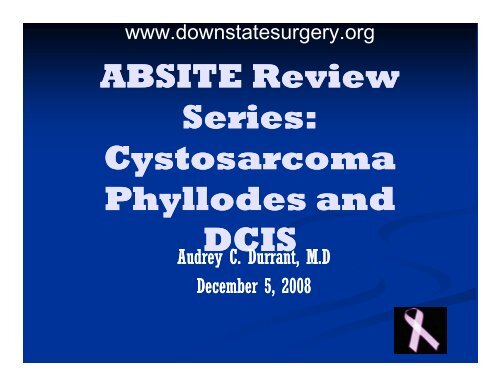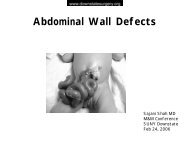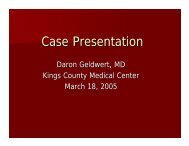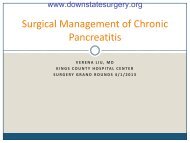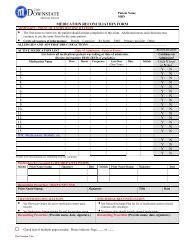ABSITE Review Series: Cystosarcoma Phyllodes Phyllodes and y ...
ABSITE Review Series: Cystosarcoma Phyllodes Phyllodes and y ...
ABSITE Review Series: Cystosarcoma Phyllodes Phyllodes and y ...
- No tags were found...
You also want an ePaper? Increase the reach of your titles
YUMPU automatically turns print PDFs into web optimized ePapers that Google loves.
www.downstatesurgery.org<strong>ABSITE</strong> <strong>Review</strong><strong>Series</strong>:<strong>Cystosarcoma</strong><strong>Phyllodes</strong> <strong>and</strong>DCISAudrey C. Durrant, M.DDecember 5, 2008
www.downstatesurgery.org<strong>Cystosarcoma</strong> <strong>Phyllodes</strong>• Johannes Muller 1838 first to coin cystosarcoma phyllodes• Denoting cystic appearance <strong>and</strong> leaf-like like growth patterns of large tumor• Most common non-epithelial neoplasm of the breast• Accounts for 0.5-1% all breast carcinomas• Exclusive disease of women• Can occur women all ages – includes adolescents <strong>and</strong> elderly• Majority in 4 th decade of life
www.downstatesurgery.org<strong>Cystosarcoma</strong> <strong>Phyllodes</strong>• Stromal tumors well circumscribed• Typically quite large – mean diameter 4-5 cm• Present as painless mass• Solitary• Discrete• mobile• Mammographically indistinguishable from fibroadenomas• Majority are benign• 10-40% take malignant course• Decision to perform excision biopsy based on :• Large tumor size• History rapid growth• Patient age
www.downstatesurgery.org<strong>Cystosarcoma</strong> <strong>Phyllodes</strong>• Malignancy based on• High mitotic rate (>10 mitotic figures per 10 HPF)• Infiltrative borders• Areas of stromal overgrowth• Stromal overgrowth most impt predictor ofaggressive behaviour• Tend to recur regardless of malignancy• Depending on series – local recurrence• 5-15% for benign tumors• 20-30% for malignant tumors
www.downstatesurgery.org<strong>Cystosarcoma</strong> <strong>Phyllodes</strong>Treatment• Surgical therapy aimed at complete excision with at least 1cmmargins• Either wide local excision or simple mastectomy• Geiser et al, at University of Oklahoma Health Science Center,Tulsa, reviewed all cases of phyllodes treated at their institutionover 24 yrs <strong>and</strong> found an increased recurrence of all tumors,benign or malignant, when margins were positive• Strongest indicator of local recurrence is a positive margin
www.downstatesurgery.orgDuctal Carcinoma inSitu (DCIS)• Incidence DCIS increasing since introductionscreening mammogram c.f. older series when DCISremained undetected until it became palpable• DCIS now accounts for approximately 20% of allnewly diagnosed breast cancers• Median age reported for patients with DCIS 47-63 yrs• Relative rates invasive ductal carcinoma remainrelatively constant
www.downstatesurgery.org• DCIS representsheterogeneous grouphistiologic changes ofvarying malignant potential• All characterized byproliferation of malignantepithelial cells withinbreast ducts withoutinvasion through basementmembrane• May be associatedinflammatory reaction,stromal response orlymphoid infiltrationDCISPathology
www.downstatesurgery.orgDCISPathology• Generally classified as 1 of 5 subtypes:• Comedo• Solid• Cribiform• Micropapillary• papillary• Based on differences architectural pattern cancercells <strong>and</strong> nuclear features• DCIS broadly characterized as comedo <strong>and</strong> noncomedo
www.downstatesurgery.orgDCISPathology• Noncomedo: all subtypes that lack centralnecrotic cellular debris• Comedo necrosis correlates with increasedrisk of local recurrence <strong>and</strong> invasion• Nuclear features used to classify lesionsas low, intermediate or high grade
www.downstatesurgery.orgDCISNatural History• DCIS is a precursor of invasive breast cancer• Not all DCIS will become breast cancer• However, most women with low-grade DCISleft untreated will eventually develop invasivebreast cancer at the same site
www.downstatesurgery.org• Usually found by presencemicrocalcifications onscreening mammography• Calcifications that t representDCIS usually linear orbranching pattern• May present as palpablemass, mammographic massor bloody nipple dischargeDCISPresentation
www.downstatesurgery.orgDCISDiagnosis• Stereotatic biopsy• Mammogram directed d biopsy obtained byradiologist• Core needle biopsy• Radiologist or surgeon use hollow needle toremove tissue sample with palpable mass• Surgical biopsy (wide local excision orlumpectomy)• If core needle or stereotactic biopsy showareas atypical hyperplasia or confirm DCIS orinconclusive in face highly suspiciousmammogram• Performed with assistance or per-operativeneedle localization of mammographicabnormality• Bx should aim for negative margins – approx 1cm
www.downstatesurgery.orgMastectomy vs BreastConservation Surgery• In past DCIS treated with MRM• Rationale was based on high incidence ofmultifocality <strong>and</strong> multicentricity• Current recommendations advocate BCS• Lumpectomy followed by radiation therapy mostcommon treatment for DCIS• R<strong>and</strong>omized trials have indicated that the additionof tamoxifen decreased contralateral breast cancer<strong>and</strong> ipsilateral recurrence in patients with invasivecancer
www.downstatesurgery.orgMastectomy vs BCS• Mastectomy indicated• Diffuse malignant appearing calcifications• Persistent positive margins after attempted BCS• Large (i.e. >3cm) high grade DCIS• Patient t preference• Radiation contraindicated
www.downstatesurgery.orgDCISOutcomes• In general overall survival rate excellent• Weng et al. reported overall survival rate of97% at 8 yrs• Local recurrence rates in this series were 25%for pts with DCS treated with BCS only• 13% for BCS <strong>and</strong> radiation• 4% for those treated with mastectomy• About 50% pts with recurrences after DCIShave invasive tumors
www.downstatesurgery.orgSurveillance• Following BCS: post surgical mammogram should beobtained to screen for residual micro-calcificationscalcifications• Mammogram should be obtained 4-6 months aftercompletion of radiation therapy to establish newbaseline• F/U of pts after BCS <strong>and</strong> radiation should includetwice yearly PE <strong>and</strong> annual mammogram for first 5years• Annual PE <strong>and</strong> mammogram thereafter
www.downstatesurgery.orgSurveillance (cont’d)• Both pts treated with BCS <strong>and</strong> mastectomyshould be monitored closely for new primarycancers in the contralateral breast• Risk that new primary cancer will develop incontralateral breast after treatment for DCISis 2-5 times the risk of development of a firstprimary breast cancer
www.downstatesurgery.orgQuestions1. <strong>Phyllodes</strong> tumors:a) Present in postmenopausal womenb) Are often malignantb)c) Require mastectomy because of their highrecurrence rated) Tend to recure) Are responsive to hormonal manipulation
www.downstatesurgery.orgQuestions2. All of the following is true about <strong>Cystosarcoma</strong>phyllodes of the breast except:a) Is the most common primary breast sarcomaa)b) Treatment is local excision with margin of normal tissuec) Only 10% are malignantd) Lymph node dissection is not indicatede) In the male patient t the prognosis is worse
www.downstatesurgery.orgQuestions3. Which of the following statements is incorrectregarding ductal carcinoma in situ?a) Breast-conservation therapy should be done forlocalized disease, ,p particularly non comedo varietyb) Axillary lymph node dissection is not necessaryc) The most common clinical presentation is apalpable massd) After breast-conserving surgery, radiotherapy isadministered in tangential fields to the wholebreaste) There is no role for chemotherapy in the treatmentof DCIS
www.downstatesurgery.orgQuestions4. Which of the following treatments is best for a 40yr old woman with extensive microcalificationsinvolving the entire upper aspect of the rightbreast <strong>and</strong> biopsy that show a comedo pattern ofDCIS?a) Local excision aloneb) Irradiation alonec) Local excision plus irradiationd) Right total mastectomye) Right total mastectomy followed by irradiatione)


